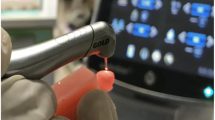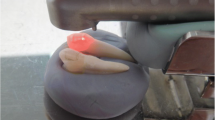Abstract
Several techniques have been proposed to obtain a durable bond, and the efficacy of these techniques is assessed by measuring parameters such as bond strength. Laser has provided a bond strength as high as that of acid etching in vitro and has simpler use with shorter clinical time compared to acid etching. This study aimed to compare the efficacy of Er:YAG and Er,Cr:YSGG lasers for etching and bonding of composite to orthodontic brackets. No previous study has evaluated the effect of these particular types of laser. A total of 70 composite blocks were randomly divided into five groups (n = 14): group 1, etching with phosphoric acid for 20 s; group 2, Er:YAG laser irradiation with 2 W power for 10 s; group 3, Er:YAG laser with 3 W power for 10 s; group 4, Er,Cr:YSGG laser with 2 W power for 10 s; group 5, Er,Cr:YSGG laser with 3 W power for 10 s. Metal brackets were then bonded to composites, and after 5000 thermal cycles, they were subjected to shear bond strength test in a universal testing machine after 24 h of water storage. One sample of each group was evaluated under a scanning electron microscope (SEM) to assess changes in composite surface after etching. The adhesive remnant index (ARI) was calculated under a stereomicroscope. Data were statistically analyzed. The mean and standard deviation of shear bond strength were 18.65 ± 3.36, 19.68 ± 5.34, 21.31 ± 4.03, 17.38 ± 6.94, and 16.45 ± 4.26 MPa in groups 1–5, respectively. The ARI scores showed that the bond failure mode in all groups was mainly mixed. The groups were not significantly different in terms of shear bond strength. Er:YAG and Er,Cr:YSGG lasers with the mentioned parameters yield optimal shear bond strength and can be used as an alternative to acid etching for bracket bond to composite.





Similar content being viewed by others
References
Furuse AY, Cunha LF, Benetti AR, Mondelli J (2007 Dec) Bond strength of resin-resin interfaces contaminated with saliva and submitted to different surface treatments. J Appl Oral Sci 15(6):501–505
Hammad SM, El Banna MS (2013) Effects of cyclic loading on the shear bond strength of metal orthodontic brackets bonded to resin composite veneer surface using different conditioning protocols. Prog Orthod 14:14. https://doi.org/10.1186/2196-1042-14-14
Jafarzadeh Kashi TS, Erfan M, Rakhshan V, Aghabaigi N, Tabatabaei FS (2011) An in vitro assessment of the effects of three surface treatments on repair bond strength of aged composites. Oper Dent 36:608–617
Bouschlicher MR, Reinhardt JW, Vargas MA (1997) Surface treatment techniques for resin composite repair. Am J Dent 10(6):279–283
Sobouti F, Dadgar S, Sanikhaatam Z, Nateghian N, Saravi MG (2016) Effects of two erbium-doped yttrium aluminum garnet lasers and conventional treatments as composite surface abrasives on the shear bond strength of metal brackets bonded to composite resins. J Orthod Sci 5(1):18–24. https://doi.org/10.4103/2278-0203.176654
Alizadeh Oskoee P, Mohammadi N, Ebrahimi Chaharom ME, Kimyai S, Pournaghi Azar F, Rikhtegaran S, Shojaeei M (2013) Effect of surface treatment with Er; Cr: YSSG, Nd: YAG, and CO2 lasers on repair shear bond strength of a silorane-based composite resin. J Dent Res Dent Clin Dent Prospects 7(2):61–66. https://doi.org/10.5681/joddd.2013.011.
Armengol V, Jean A, Marion D (2000 Mar) Temperature rise during Er: YAG and Nd: YAP laser ablation of dentin. J Endod 26(3):138–141
Hoke JA, Burkes Jr EJ, Gomes ED, Wolbarsht ML (1990) Erbium: YAG (2.94 μm) laser effects on dental tissues. J Laser Appl. Summer-Fall;2(3–4):61–5.
Hibst, Raimund, and Ulrich Keller (1993) Mechanism of Er: YAG laser-induced ablation of dental hard substances. OE/LASE93: Optics, Electro-Optics, & Laser Applications in Science& Engineering. International Society for Optics and Photonics
Mirzaei M, Yasini E, Tavakoli A, Chiniforush N (2015) Effect of different powers of Er,Cr:YSGG laser treatment on surface morphology of microhybride composite resin: scanning electron microscope (SEM) evaluation. J Lasers Med Sci 6(2):62–66
Chiniforush N, Nokhbatolfoghahaei H, Monzavi A, Pordel E, Ashnagar S (2016) Surface treatment by different parameters of erbium:yttrium-aluminum-garnet (Er:YAG) laser: scanning electron microscope (SEM) evaluation. J Lasers Med Sci 7(1):37–39. https://doi.org/10.15171/jlms.2016.08
Topcuoglu T, Oksayan R, Ademci KE, Goymen M, Usumez S, Usumez A (2013) Effects of water flow rate on shear bond strength of orthodontic bracket bonded to enamel surface after Er:YAG laser ablation. Photomed Laser Surg 31(10):486–491
Berk N, Basaran G, Ozer T (2008 Apr) Comparison of sandblasting, laser irradiation, and conventional acid etching for orthodontic bonding of molar tubes. Eur J Orthod 30(2):183–189. https://doi.org/10.1093/ejo/cjm103
Hammad SM, El Banna MS (2013) Effects of cyclic loading on the shear bond strength of metal orthodontic brackets bonded to resin composite veneer surface using different conditioning protocols. Prog Orthod 14:14
Reynolds I (1975) A review of direct orthodontic bonding. Br J Orthod 2:171–178
Moseley HC, Horrocks EN, Pearson GJ, Davies EH (1995) Effects of cyclic stressing on attachment bond strength using glass ionomer cement and composite resin. Br J Orthod 22:23–27
Saraç YS, Külünk T, ElekdagTürk S, Saraç D, Türk T (2011) Effects of surface-conditioning methods on shear bond strength of brackets bonded to different all-ceramic materials. Eur J Orthod 33:667–672
Littlewood SJ, Mitchell L, Greenwood DC (2001) A randomized controlled trial to investigate brackets bonded with a hydrophilic primer. J Orthod 28:301–305
Eslamian L, Borzabadi-Farahani A, Mousavi N, Ghasemi A (2012) A comparative study of shear bond strength between metal and ceramic brackets and artificially aged composite restorations using different surface treatments. Eur J Orthod 34:610–617
Brosh T, Pilo R, Bichacho N, Blutstein R. Effect of combinations of surface treatments and bonding agents on the bond strength of repaired composites. J Prosthet Dent. 1997;77:122–6
Sobouti F, Dadgar S, Sanikhaatam Z, Nateghian N, Saravi MG (2016) Effects of two erbium-doped yttrium aluminum garnet lasers and conventional treatments as composite surface abrasives on the shear bond strength of metal brackets bonded to composite resins. J Orthod Sci 5(1):18–24
Palasuk J, Platt JA, Cho SD, Levon JA, Brown DT, Hovijitra ST. Effect of surface treatments on microtensile bond strength of repaired aged silorane resin composite. Oper Dent. 2013;38:91–9
Soderquist SA, Drummond JL, Evans CA (2006) Bond strength evaluation of ceramic and stainless steel bracket bases subjected to cyclic tensile loading. Am J Orthod Dentofacial Orthop 129:175.e7–175.e12
Swift EJ Jr, LeValley BD, Boyer DB (1992) Evaluation of new methods for composite repair. Dent Mater 8:362–365
Eslamian L, Borzabadi Farahani A, Mousavi N, Ghasemi A (2011) The effects of various surface treatments on the shear bond strengths of stainless steel brackets to artificially-aged composite restorations. Aust Orthod J 27:28–32
Hosseini MH, Sobouti F, Etemadi A, Chiniforush N, Shariati M (2015) Shear bond strength of metal brackets to feldspathic porcelain treated by Nd: YAG laser and hydrofluoric acid. Lasers Med Sci 30:837–841
Cavalcanti BN, Lage-Marques JL, Rode SM (2003) Pulpal temperature increases with Er:YAG laser and high-speed handpieces. J Prosthet Dent 90:447–451
Shahdad SA, Kennedy JG (1998) Bond strength of repaired anterior composite resins: An in vitro study. J Dent, 26:685–694
Bonstein T, Garlapo D, Donarummo J Jr, Bush PJ (2005) Evaluation of varied repair protocols applied to aged composite resin. J Adhes Dent 7:41–49
Rossato D, Bandeca MC, Saade E, Lizarelli R, Bagnato VS, Saad J (2009) Influence of Er:YAG laser on surface treatment of aged composite resin to repair restoration. Laser Phys 19(11):2144–2149
Kimyai S, Mohammadi N, Navimipour EJ, Rikhtegaran S (2010) Comparison of the effect of three mechanical surface treatments on the repair bond strength of a laboratory composite. Photomedicine and Laser Surgery ;28(S2):S-25-S-30
Hosseini MH, Namvar F, Chalipa J, Saber K, Chiniforush N, Sarmadi S et al (2012) Comparison of shear bond strength of orthodontic brackets bonded to enamel prepared by Er:YAG laser and conventional acid-etching. J Dent 9(1):20–26
Berk N, Basaran G, Ozer T (2008) Comparison of sandblasting, laser irradiation, and conventional acid etching for orthodontic bonding of molar tubes. Eur J Orthod 30(2):183–189
Sinha PK, Nanda RS, Duncanson MG, Hosier MJ (1995) Bomd strenghts abd remnant adhesive resin on debonding for orthodontic bonding techniques. Am J Orthod Dentofac Orthop 108:302–307
Fernandez L, Canut JA (1999) In vitro comparison of the retention capacity of new aesthetic brackets. Eur J Orthod 21:71–77
Smith DC, Maijer R (1983) Improvements in bracket base design. Am J Orthod 83(4):277–281
Lee BS, Hsieh TT, Lee YL, Lan WH, Hsu YJ, Wen PH, Lin CP (2003) Bond strengths of orthodontic bracket after acid-etched, Er:YAG laser irradiated and combined treatment of enamel surface. Angle Orthod 73(5):565–570
Valleta R, Prisco D, De Santis R, Ambrosio L, Martina R (2007) Evaluation of the debonding strength of orthodontic brackets using three different bonding systems. Eur J Orthod 29:571–577
Acknowledgements
The authors would like to thank the Laser Research Center of Dentistry, Dentistry Research Institute, Tehran University of Medical Sciences.
Author information
Authors and Affiliations
Ethics declarations
Conflict of interest
The authors declare that they have no conflict of interest.
Ethical approval
This study has been approved by the ethical committee of Tehran University of Medical Sciences.
Informed consent
This study was in vitro.
Rights and permissions
About this article
Cite this article
Mirhashemi, A.H., Chiniforush, N., Sharifi, N. et al. Comparative efficacy of Er,Cr:YSGG and Er:YAG lasers for etching of composite for orthodontic bracket bonding. Lasers Med Sci 33, 835–841 (2018). https://doi.org/10.1007/s10103-017-2417-1
Received:
Accepted:
Published:
Issue Date:
DOI: https://doi.org/10.1007/s10103-017-2417-1




